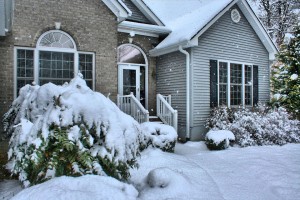Pros and Cons of Repairing and Installing Siding in the Winter
 Winter in Canada brings with it excessive snow, chilly temperatures, and biting winds – conditions that can be tough on your home’s exterior. Quality siding – whether wood, Celect® cellular composite, or vinyl – will help defend your house against nature’s harshest elements. If you’re considering exterior renovations, there can be benefits to undertaking work in the wintertime.
Winter in Canada brings with it excessive snow, chilly temperatures, and biting winds – conditions that can be tough on your home’s exterior. Quality siding – whether wood, Celect® cellular composite, or vinyl – will help defend your house against nature’s harshest elements. If you’re considering exterior renovations, there can be benefits to undertaking work in the wintertime.
To help inform your decision, we’ve put together a list of pros and cons of working on siding in the winter:
Pros of Fixing Siding in the Winter
1. Convenient Installation and Lower Costs
For most contractors, winter is a slower time of year. That’s good news if you’re looking to have work done on your home. Crews will be more flexible and have greater availability, making it easier to complete the project efficiently. Due to the decreased demand, you’ll also be able to enjoy more competitive rates.
2. Avoid Side Effects of Summer Heat on Paint and Vinyl Siding
Like Goldilocks, paint likes the temperature neither too cold nor too hot. It has to be just right. If your home’s exterior surfaces are too hot (their temperatures can be five to eleven degrees higher than the air around them) good paint film will be unable to form, triggering problems down the road.
Vinyl siding can be equally sensitive. It’s prone to expanding in the summer heat, which can cause it to buckle if it’s nailed too tightly during installation.
3. Stop Problems in Their Tracks
If you find problems – whether cracks, missing pieces, or discolouration – you need to get them assessed fast. If moisture seeps under your siding, it can cause further costly damage to your home’s exterior. Cold temperatures will also exacerbate existing issues. With a material like wood, water that permeates gaps will freeze in cold weather, expanding cracks and aggravating damage.
Cons of Working on Siding in the Winter
1. Harsh Winter Weather
Winter weather can be challenging for crews working on your home. If it’s too cold or there’s too much snow or ice, they might not be able to undertake work. Experienced contractors will know the limits of their own teams. They’ll be able to communicate these to you, and ensure work is completed efficiently without compromising their crews’ well-being.
2. Delayed Completion
Although the weather can be unpredictable in any season, the effects can be more pronounced in the winter. Frigid temperatures and unexpected storms might delay work by a few hours or even a few days. If there is excessive snow buildup, contractors might not be able to start the process until spring, as they will not be able to access your walls.
3. Cold-Sensitive Materials and Equipment
Like people, equipment and materials can be sensitive to wintry temperatures. Contractors must be careful with vinyl siding, which can become brittle and more prone to cracking. Many paint manufacturers also caution against applying their products in the cold. If paint doesn’t dry properly, it will compromise your home’s moisture barrier and cause problems later on.
The performance of a pneumatic drill, which is responsible for driving nails to secure siding in place, is also compromised by winter chills. It might need to be warmed up periodically throughout the day and should be drained regularly to prevent fluids from freezing. When not in use, it should be kept in a heated, dry area to prevent moisture from accumulating in the lines.
Maintaining Your Siding
To keep your siding healthy and vibrant for years to come, routine maintenance is key:
- Caulking: Do a thorough check around vents, doors, and windows. If damage is minor, you can re-caulk it yourself. If it looks more significant you’re suspicious moisture may have penetrated, get it inspected so you don’t seal moisture in and create bigger problems for yourself in the future.
- Stains: Look under the eaves outside your house and on your walls and ceiling inside for discolouration, moisture buildup, or mold. The moisture may have originated elsewhere (like on your roof), but you want to get the situation assessed so you can find the cause and fix the problem before it spreads.
- Eavestroughs: Remove debris (fallen leaves, gravel, dirt, etc.) to ensure water will drain properly.
- Visual Inspection: Look for bubbles, cracks, peeling, discolouration, or missing pieces. These visual clues could indicate there’s a larger problem lurking beneath.
If you spot any issues, call a professional to assess the damage and recommend necessary repairs or replacements.
At Quality Exteriors, we are vinyl, wood, and Celect® cellular composite siding experts. Contact us today to inquire about repairs and installations and schedule a free in-home consultation.
Visit our siding gallery to see our quality workmanship.
Serving homeowners in St. Catharines, Burlington, Hamilton, Niagara, and Oakville.
Like this? You might also like:
- Pros and Cons of Vinyl Siding
- 10 Signs Your Home’s Siding Needs Replacing
- Why Quality Siding Is a Good Investment in Your Home
- When to Request an Estimate for Exterior Work - February 26, 2020
- Merry Christmas from Quality Exteriors - December 18, 2019
- Quality Exteriors Listed In Top 3 Window Companies In St. Catharines - December 5, 2019






